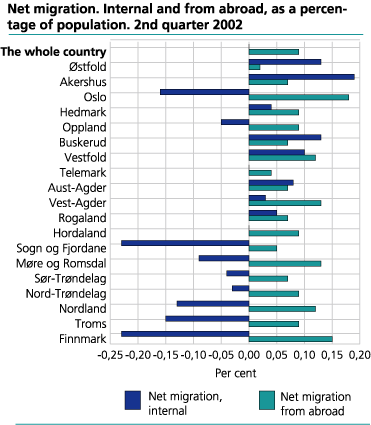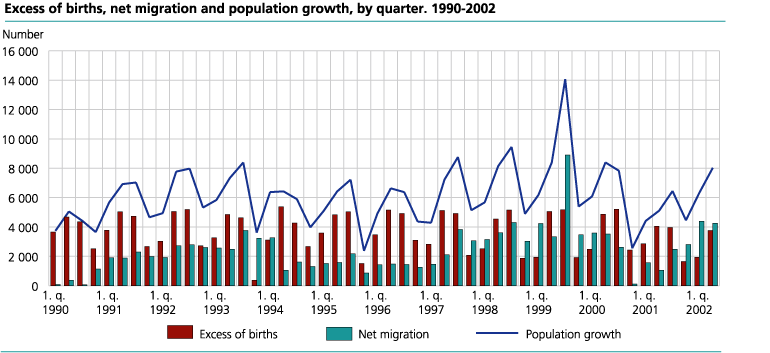Content
Published:
This is an archived release.
Increased immigration, fewer births
Registered immigration has increased markedly. The immigration surplus stands at 8 700 persons so far this year. At the same time natural growth declines, as fewer babies are born.
Registered immigration to Norway has increased markedly again. During the first half of 2002 18 300 persons moved to Norway, against 14 500 in the same period last year. The figure for the first six months of the year thereby resembles the top in 2000.
At the same time there is a decrease in the emigration from Norway, down to 9 600 so far this year. Last year and the year before the corresponding figures were higher, in 2001 at 11 900. Net immigration to the country is 8 700 persons, this is approximately 6 100 persons more than for the same period last year but closer to the levels of 1999 and 2000. The decrease in 2001 thus does not seem to indicate a more long-term declining trend.
Asylum seekers who come to Norway seeking refuge are normally included in the migration statistics only when they are granted asylum (and thereby receive a personal identification number). Those who are not allowed to stay are not included in the statistics. It may take a while before a group of asylum seekers is reflected in the migration figures, due to the handling time before residence is granted. Therefore, the variation in the migration figures does not give an exact picture of the variation in the in-flow.
Asian immigration continues to increase, because of the Iraqies
For Asian citizens the immigration surplus is 4 300 so far this year. Compared with the first half of 2001 there is an increase in almost all the groups of Asian citizens. The number of Iraqi citizens immigrating makes them the largest single group of Asian immigrating. They are partly resettlement refugees and partly asylum seekers who eventually are granted residence permits, and the group is on its way to becoming the sixth largest group of immigrants in Norway. Till now this year more than 1 500 immigrations have been registered for Iraqis.
Somali citizens are the main group of immigrants from Africa, the total immigration surplus from Africa was 1 300 for the first six months of the year.
Almost one fifth of the immigration surplus of 2 500 from Europe can be ascribed to Russian citizens. For Yugoslavian citizens the situation in 2001 was characterized by a return flow to Yugoslavia, this is no longer the case, according to the halfyear figures. The immigration surplus versus Western Europe is 800, and it is particularly the British who now move to rather than from Norway.
Norwegian citizens move in and out of Norway too. There is balance per 1 July, with approximately 4 200 migrations in each direction. At the same time last year there was a net emigration of almost 700, this is now reduced by 500 persons.
Fewer births lead to lower excess of births
A deceasing number of babies are born, there were 28 000 live births between 1 January and 1 July this year. Compared with the first half of 2001 the number of births has decreased by 1 300. The number of births has not been this low since the end of the 1980s. The number of deaths is 22 300 so far this year, approximately the same as one year ago. The excess of births ended at 5 700 in the first half of 2002, against 6 900 in 2001.
4 538 000 inhabitants
The immigration surplus is the main reason why the population increase (that is, excess of births plus net migration) has risen by 4 800 from 9 500 in the first half of 2001 to 14 400 in the same period this year. Per 1 July 2002 the preliminary total population figure is 4 538 400 residents.
The statistics is published with Population.
Contact
-
Statistics Norway's Information Centre
E-mail: informasjon@ssb.no
tel.: (+47) 21 09 46 42


